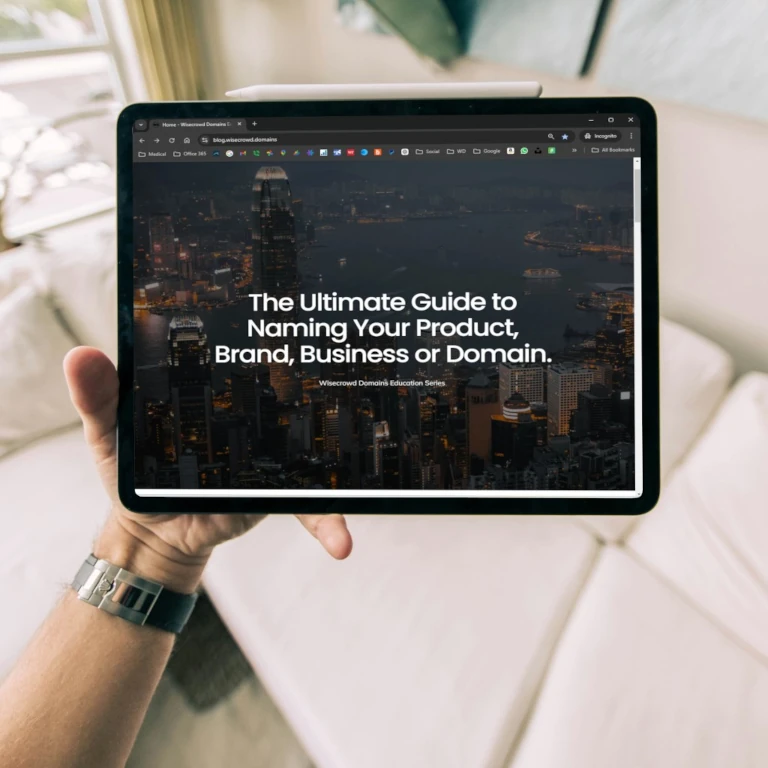Highlight common pitfalls and how to avoid them to create a strong, lasting brand name.
Naming a business is one of the most crucial steps in establishing a strong, recognizable brand. However, the process is fraught with potential pitfalls that can lead to confusion, legal issues, and missed opportunities. In this guide, we’ll outline the most common branding mistakes and offer strategies for creating a name that resonates with your target audience and stands the test of time.
S01-E002
Top Branding Mistakes to Avoid When Naming Your Business
Listen to this article as a fast 10-minute podcast.
1. Ignoring the Target Audience
The foundation of any brand is its audience. A business name should resonate with the demographic it aims to serve. Some names might feel innovative or clever to the founder but can leave potential customers confused or indifferent.
How to Avoid This Mistake:
- Research your audience to understand what appeals to them. Are they looking for professionalism, reliability, or maybe creativity?
- Test name ideas with a sample audience to gauge their reactions and impressions.
Example Pitfall: A high-end boutique aimed at luxury consumers with a name that sounds too casual or trendy could miss the mark.
2. Choosing a Name That’s Too Descriptive or Too Generic
While it’s tempting to pick a name that describes what your business does, an overly descriptive name can limit future growth or feel uninspired. Conversely, names that are too generic fail to stand out in a crowded marketplace.
How to Avoid This Mistake:
- Aim for balance: a name that reflects your brand’s essence without boxing you into one specific offering.
- Experiment with unique wording that evokes a feeling or image without explicitly stating your business activity.
Example Pitfall: Naming a tech company “Tech Services” limits brand potential and is easily forgettable. Opting for a more brandable term, such as “SparkWorks”, evokes energy and innovation without being too literal.
3. Overlooking the Legal Implications
Legal considerations are often overlooked, yet a name that’s already trademarked or registered can lead to costly legal battles and potential rebranding. A legal dispute over a name can set a business back both financially and in terms of reputation.
How to Avoid This Mistake:
- Conduct a trademark search on databases like the USPTO Trademark Search to ensure the name isn’t already taken.
- Check local and international availability if you plan to expand globally.
Example Pitfall: A small clothing boutique opens under a catchy name, only to find out it’s trademarked by a larger fashion brand. This leads to a forced rebrand, which can damage reputation and cost valuable resources.
4. Making the Name Hard to Spell or Pronounce
A name that’s difficult to spell or pronounce can create barriers for customers who want to find or refer to your business. Ideally, your business name should be something people can easily share in conversation or type into a search engine.
How to Avoid This Mistake:
- Conduct the “radio test”: Imagine someone saying your name on the radio or over the phone. If it’s clear and easy to understand without spelling, it passes.
- Avoid unconventional spellings or excessive use of special characters, as these can confuse potential customers.
Example Pitfall: A tech startup chooses a name like “Technohlgy” instead of “Technology.” While it may look unique, it’s challenging to remember and could drive away potential clients.
5. Limiting Future Growth
Choosing a name that’s too narrow or product-specific can hinder growth if you decide to diversify your offerings. A business name should ideally be versatile enough to allow for future expansion without necessitating a rebrand.
How to Avoid This Mistake:
- Choose words that represent your brand’s mission rather than a specific product.
- Avoid overly specific descriptors like “cupcakes” or “books” in the name if you might branch out.
Example Pitfall: A company named “JuiceBox Smoothies” may struggle if they decide to add snacks or other beverages to their product line. Opting for something broader like “JuiceBox Kitchen” could offer more flexibility.
6. Not Considering Domain and Social Media Availability
In today’s digital age, a business name without a corresponding domain or social media handles can hinder your online presence. Securing a matching domain and social media usernames is essential for branding consistency and making it easy for customers to find you online.
How to Avoid This Mistake:
- Use tools like Namechk to search for available domains and social media usernames.
- Consider alternatives if the exact match is unavailable but ensure the variation is intuitive.
Example Pitfall: A company chooses the name “GreenLeaf” but finds that the domain GreenLeaf.com is taken. Choosing an available and intuitive variation, like “GreenLeafCo.com” or “GetGreenLeaf.com,” could solve this issue.
7. Falling for Trends
Trendy words, phrases, or naming conventions might seem appealing but can quickly date your brand. Names that were popular in the 2000s, for instance, might feel outdated today. A timeless brand name will have enduring appeal and maintain relevance as trends shift.
How to Avoid This Mistake:
- Focus on core brand values instead of fads.
- Use words with lasting appeal or meanings tied to your brand’s mission.
Example Pitfall: A tech company using “Cyber” in its name may find the term feels outdated as technology evolves, whereas a name focusing on broader themes of innovation could remain relevant.
8. Using Industry Jargon or Buzzwords
Names with industry jargon may alienate customers outside of that field or confuse people unfamiliar with the terminology. Additionally, buzzwords tend to fade over time, making your name sound dated or unrelatable.
How to Avoid This Mistake:
- Stick to clear, universal language that appeals to a broad audience.
- Avoid overly technical terms unless your target audience is familiar with them.
Example Pitfall: A marketing firm names itself “FunnelMatrix.” While it may appeal to marketers, it could confuse clients unfamiliar with industry terms. A name like “BrightPath Marketing” may convey expertise without alienating potential clients.
9. Failing to Create a Unique Identity
A brand name that sounds similar to competitors can dilute your identity and make it harder for customers to differentiate you from others. Your brand name should stand out in your industry, not blend in.
How to Avoid This Mistake:
- Research competitor names and ensure your name doesn’t sound too similar.
- Use creative elements such as unique words, mashups, or portmanteaus that give you a distinct identity.
Example Pitfall: If you’re in the fitness industry and name your gym “FitForce,” it may be hard to differentiate from similar names like FitBody or FitPower. A unique name like “PowerRise Fitness” is easier to remember.
10. Not Testing for Audience Feedback
Many businesses skip the critical step of testing potential names with their target audience. Without feedback, you risk choosing a name that doesn’t resonate or worse, confuses your audience.
How to Avoid This Mistake:
- Gather input from focus groups or surveys to see how your name is perceived.
- Conduct A/B testing with a small group if you have multiple name ideas.
Example Pitfall: A business picks the name “NovaQuest,” assuming it’s intriguing. However, feedback might reveal that customers find it confusing or difficult to relate to the brand’s mission.
Try Some Names with Our AI Name Generator Tool
Brainstorm a Name Based on Brand or Keywords
Simply type a brand name or keyword, and we will use some cutting edge AI to brainstorm some relevant alternatives.
And if You Liked Any of Those, Copy Them Straight into the Domain Name Check Tool
Check Domain Availability
Simply click through your new domain (or the suggested alternatives) to register it today. Hurry, your competitors are thinking the same thing.
Conclusion
Naming your business is an art and a science, with each choice carrying significant implications for your brand’s future. By avoiding these common mistakes, you can select a name that’s memorable, scalable, legally secure, and resonates with your audience. A well-chosen name can be the cornerstone of a strong, lasting brand that thrives in both the physical and digital worlds.
A thoughtful approach to naming can set your brand up for success, making it easy for customers to find, remember, and trust you. Keep these tips in mind to avoid pitfalls and create a name that will grow with your business for years to come.
This guide provides practical insights into naming a business effectively while sidestepping common branding mistakes.






5 responses to “Top 10 Branding Mistakes to Avoid (At All Costs) When Naming Your Business”
“This was such an eye-opener! I hadn’t realized how common it was to choose names that limit growth. Thank you for the insight!”
“Great advice! I almost made the mistake of picking a trendy name that wouldn’t age well. I’ll definitely think longer-term now.”
“So helpful! I loved the point about avoiding names that are hard to spell. It’s something I overlooked, but I see how important it is.”
“Thank you for these tips! I was leaning toward a play on words, but your advice on clarity made me rethink my choice.”
“This was a fantastic read. The advice about researching potential trademark issues was particularly valuable. Saved me from a big mistake!”